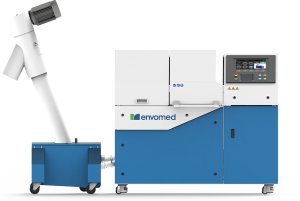Medical Waste and Climate Change – the vicious cycle we CAN fix.
Medical Waste and Climate Change – the vicious cycle we CAN fix.
Climate change is never far from the headlines. However, one topic that’s rarely spoken about in connection with climate change is medical waste. A well-functioning health-care sector should help to mitigate the negative effects of pollution and climate change on public health. However, in doing so, the healthcare sector itself contributes significantly to the global carbon footprint.
The rate of carbon emissions generated by medical waste is staggeringly high. This, coupled with the need for increased healthcare to combat the effects of climate change and pollution, represents a vicious cycle.
However, help is at hand. New technology engineered to reduce the carbon footprint of medical waste treatment is beginning to roll out across the globe. In this article, we’ll examine why this breakthrough is even more important than you may think.
Impact of medical waste on the Environment
The healthcare sector is reported to contribute a total of 4.4% of global carbon emissions (2019) – a staggering amount from a single source. 70% of this is believed to come from medical waste.
Treating medical waste effectively without suitable technology is incredibly challenging. You can read more about why it’s so difficult in this article. The current, most prevalent methods of waste treatment involve transporting waste to external treatment facilities followed by landfill – a process that is not optimal for public health or the environment.
Landfills, as we know, are not an effective solution to the problem of global waste. As far as medical waste is concerned, the post-treatment remnants decompose slowly and accumulate significantly over time, posing both environmental and public health risks.
The problem is a global one. The carbon-intensive resource cycle of healthcare around the world means greenhouse gasses (GHG) are constantly being released into the atmosphere.
The most developed nations are often even more culpable when it comes to healthcare-based carbon emissions. In the USA the ratio of medical to total carbon emissions has been reported to be close to 10%, while in the UK it sits at 6.3%. China also has a similarly high ratio.
Where do the carbon emissions come from?
The healthcare industry has many sources of carbon emissions. Some practices and systems directly contribute to the sector’s carbon footprint, while others indirectly affect it. They can be broadly separated into four categories:
1. Medical Waste
The most significant contributor to the carbon footprint of the healthcare sector is its disposable waste. In fact, medical waste and the treatment of it contributes close to 70% of the total carbon footprint of the entire medical industry.
This problem is exacerbated in developed nations where reusable equipment is less prevalent.
However, the answer isn’t necessarily to adopt more reusable equipment. Instead, the main problem lies with the inefficiency of off-site waste treatment processes. Most of these processes utilise facilities that are too far away from the hospital, making trips there more expensive. This encourages hospitals to let medical waste accumulate for longer before sending it for treatment – leading to public health risk.
Also, off-site waste treatment facilities such as incinerators, autoclaves and microwaves are a major culprit when it comes to CO2 and toxic gas emissions. Even more worryingly, as discussed in this article, such methods leave room for doubt when it comes to the effectiveness waste sterilization – posing a further risk to public health.
2.Energy Usage
High-tech medical machinery requires a lot of power to run. However, interestingly most medical energy waste doesn’t come from those devices. Instead, a significant lack of efficiency in the energy conversion of regular utilities like lighting, heating, and transport is a bigger energy-wasting culprit and most hospitals are not run using clean energy, exacerbating the problem.
Medical facilities generally have carbon-intensive supply chains. Transport, R&D, and application all involve a tremendous amount of carbon emissions.
As the medical transportation system is unoptimized, globally-speaking – what if some important processes, like waste treatment, could be carried out safely in-house instead of requiring transportation?
3.Cooling
Medical cooling facilities and instruments produce a large amount of carbon emissions. Circa 365MTCO2e is produced by hospital cooling around the world annually- that’s close to 100 coal-powered power plants.
Hospital cooling systems also use a tremendous amount of HCFC and HFCs. These gasses are highly toxic to the environment and are believed to contribute significantly to climate change.
Cooling falls under the ‘indirect emissions’ category, and contributes 12% to the carbon footprint of the entire sector.
Even in instances where hospitals have on-site autoclaves or microwaves for medical waste treatment, there are clear environmental consequences with the increased need for cooling.
4.Chemical Fumes
Chemical fumes are a direct source of CO2 emissions. Some pharmaceuticals and other chemicals commonly used the healthcare sector are responsible for releasing potentially toxic particles into the air.
For example, metered dose inhalers— a widely used method of treating respiratory conditions such as asthma—use hydrofluorocarbons. These act as a propellant and contain a number of carbon particles which are released into the atmosphere.
Solving the problem of medical waste treatment
As we have seen in this article, there are many factors within the healthcare industry that affect global carbon emissions – inefficient medical waste treatment practices being the most significant. In the worst case, these off-site medical waste treatment processes can pose a serious public health risk too. Thankfully, change is coming.
Envomed 80 – The On-Site, Sustainable Medical Waste Treatment Solution
The Envomed 80 is an on-site medical and infectious treatment solution that treats up to 80 liters of medical and infectious waste in under 20 minutes.

Importantly, it allows hospitals and healthcare centres to treat their waste on-site. As well as instantly reducing the carbon footprint of the waste treatment process, this also reduces costs and allows for more frequent waste treatment – reducing the risk to public health of dormant untreated waste. On-site waste treatment, eliminates the need for special waste packaging to dispose of waste off-site as required by regulation (typically, a rigid, spill-proof container). This will not only reduce costs but also mitigate the carbon footprint generated when infectious waste packages are incinerated.
The Envomed 80 also guarantees effective sterilization of the waste by performing the entire disinfection process in a liquid phase, using Biocetic – a sustainable liquid disinfection solution diluted in water.
The solid waste is shredded to a confetti shape which is mixed vigorously with the disinfecting solution together with the waste liquid phase.
Therefore:
– Liquids pose no problem
– There is no need to remove the air from the chamber
– No extreme temperatures, pressure and vacuum are used
– There is no pause in between cycles – the next cycle may start immediately
The Envomed 80 offers fully validated and reproducible sterilization results.
The waste is sterilized to STAATT IV, and Envomed provides validation and verification kits in order to test and demonstrate the results – removing the risk to public health and the environment.
The Envomed 80 sterilization process is completely environmentally friendly, with no harmful emissions. As the treatment is carried out completely on-site, hospitals and healthcare centres can save money on outsourcing and transporting waste too.
To find out more about how the Envomed 80 is revolutionizing waste treatment processes across the globe, contact Envomed today






